amÃâ >r` AÃJya AZwgÃYmZ H - National Research Centre for Grapes
amÃâ >r` AÃJya AZwgÃYmZ H - National Research Centre for Grapes
amÃâ >r` AÃJya AZwgÃYmZ H - National Research Centre for Grapes
Create successful ePaper yourself
Turn your PDF publications into a flip-book with our unique Google optimized e-Paper software.
NRC <strong>for</strong> <strong>Grapes</strong> | Annual Report 2006-07<br />
At 45 and 60 days, 110R stock resulted in significantly higher P concentration than other rootstocks<br />
lowest concentration was observed in Dogridge rootstock. Own rooted vines significantly higher<br />
petiole P content then vines grafted on Dogridge rootstock at 60, 75 and 90 days. At 45 days<br />
petioles of own rooted vines had significantly higher K content compared to the three rootstocks. At<br />
90 days 110R and Dogridge rootstocks coned significantly higher K than Salt Creek. Significantly<br />
higher Zinc concentration was observed in the petioles of own rooted vines compared to grafted<br />
vines at all the stages of sampling.The studies were continued <strong>for</strong> the fruiting season 2006-07 also.<br />
Self-rooted vines contained significantly higher K than the vines raised on rootstocks at 45 days<br />
during foundation pruning 2006-2007. The vines on Salt creek rootstocks had significantly higher P<br />
content compared to vines raised on 110R. All the three rootstocks resulted in significantly less<br />
chloride concentration that own rooted vines. Significantly less Na content was found in case of vines<br />
raised on 110R rootstock compared to Dogridge and Salt Creek. Studies with respect to other<br />
nutrients and other stages are in progress.<br />
110 R rootstock resulted in significantly higher bunch number per vine during the fruiting season<br />
2006-2007. All the rootstocks produced significantly higher yield than own rooted vines. Yield per<br />
vine was highest in case of 110 R / Thompson Seedless combination and was significantly higher<br />
than Dogridge / Thompson Seedless combination. Shelf life studies showed that per cent<br />
physiological loss of water from bunch was highest in case of own rooted vines. After 8 days at<br />
ambient laboratory temperature the physiological loss in weight (PLW) was significantly higher in case<br />
of own rooted vines (14.76%) than the grafted vines. All the three rootstocks did not differ<br />
significantly with respect to the PLW.<br />
Rootstock effect on zinc content in Tas-A-Ganesh tissues (2002-2006)<br />
The vine tissues were sampled and analysed 12 times at different growth stages from the same vines<br />
between 2002-2006. The concentration of the zinc was always significantly higher in petioles of own<br />
rooted compared to grafted vines at all the stages of sampling. In 10 out of 12 sampling stages there<br />
was no significant different in zinc content in the petioles of vines grafted on 110 R and those grafted<br />
on Dogridge rootstock. The blades of own rooted vines also had significantly higher zinc content.<br />
The vines grafted on the two rootstocks also did not differ in zinc uptake. The variations in Zn<br />
concentrations observed in the tissues did not reflect in yield of the vines. The data pointed out that<br />
the own rooted vines might require different rates of zinc applications compared to grafted vines to<br />
maintain the same concentration in the vine parts.<br />
Studies on evaluation of grapevine rhizosphere and non-rhizosphere fungi <strong>for</strong> P solubilization<br />
Twelve Aspergillus isolates isolated from the rhizosphere and non- rhizosphere soils of the<br />
grapevines were evaluated <strong>for</strong> the P solubilization in the laboratory. All the isolates from rhizosphere<br />
and non- rhizosphere solubilized the P from added calcium triphosphate (250 ppm P) ranging from<br />
124.3 ppm to 178 ppm compared to only 3.3 ppm in the absolute control after 5 days of<br />
incubation. The higher content of solubilized P in case of above isolates was supported by more<br />
reduction in the pH of the media. The lowest solubilization of P was observed in case of isolate<br />
number 12 and the smallest zone diameter were also observed in the same isolate. The reduction in<br />
pH in comparison to the control was also least in case of same isolate. Further studies in this respect<br />
are in progress.<br />
| 16 |


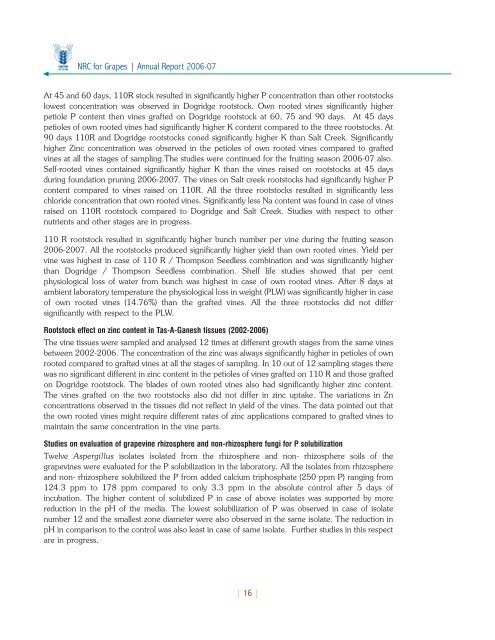


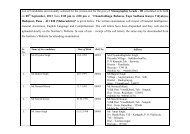
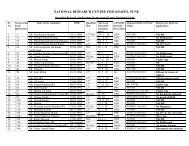

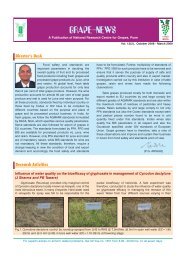

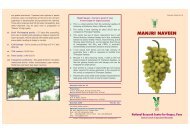
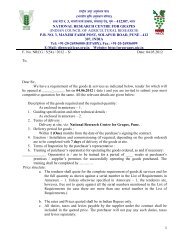



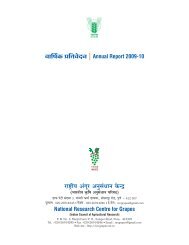
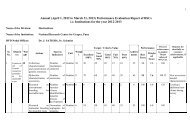
![mj]mJ{V cmcH$m{irM{ (_mBQâ¤>g) oZ`ÃÃU](https://img.yumpu.com/33367555/1/190x127/mjmjv-cmchmirm-mbqag-ozaau.jpg?quality=85)